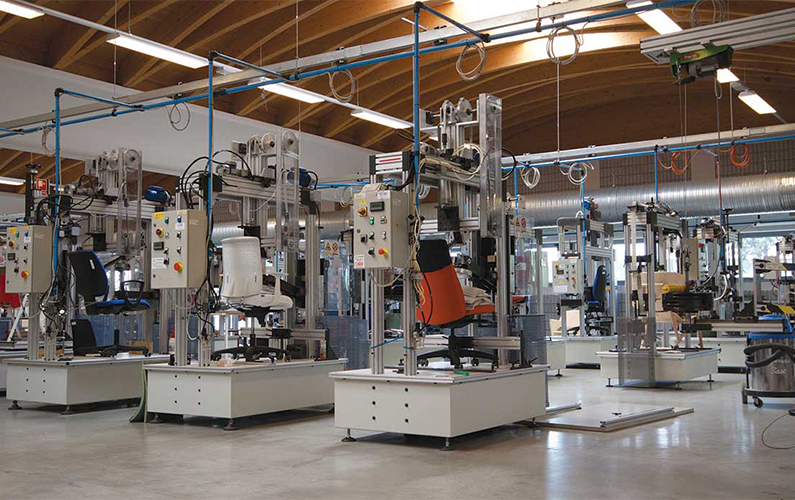What is the ANSI/BIFMA standard?
If you've shopped around in the process of learning about standing desk, you've seen this acronym in the marketing materials of many manufacturers: ANSI/BIFMA, especially those that sell exclusively to large corporations, governments and educational institutions. The acronym refers to a nonprofit standards-setting body, the Business + Institutional Furniture Manufacturers Association (BIFMA), which operates under the auspices of another nonprofit organization, the American National Standards Institute (ANSI). The highest quality office furniture products are tested to ANSI/BIFMA standards by independent laboratories (usually for-profit companies) around the world.
The office furniture industry as a whole sells approximately $46 billion in goods in the United States each year, of which only 40 percent, or $18 billion, is sold by contract office furniture manufacturing. Whether fixed-height or sit-stand desks, filing cabinets, chairs or cubicle partitions, these products are typically marketed as "ANSI/BIFMA certified" and the standards to which they are certified (e.g., "ANSI/BIFMA X5.5-2014")
Another 60% of office furniture is sold through retail and online channels, such as IKEA, Amazon, etc. With very few exceptions, these sellers do not have their products tested in independent labs to see if they meet BIFMA's durability standards. They have no reason to do so because their buyers have probably never heard of the acronym ANSI/BIFMA and often have low expectations of their durability. More and more businesses, government agencies and educational institutions are now buying as many office furniture products as possible through e-commerce, and meeting BIFMA remains a prerequisite for these customers.
What BIFMA does and does not require in terms of testing standing desk
In the standards document on standing desk, tests for "top loading, ease of loading, locking mechanisms, expandable elements or roll out shelf cycles, out of station, bounce, brackets, leg strength, horizontal and vertical adjustment, stability, cycle testing of telescopic doors, interlocks, drop testing of telescopic doors and unit drops" are discussed. In their own words, "This standard establishes acceptance levels to help ensure reasonable safety and performance, independent of construction materials, manufacturing processes, mechanical design or aesthetic design."
The lab that performs BIFMA testing on standing desk is a custom lab that performs thousands of cycles on the product, usually over a period of one to three weeks, depending on the duty cycle of the motor. Robotic sensors and actuators will simulate the user's usage habits by repeatedly moving it up and down, rocking it back and forth, and trying to make it tip over. In other words, the lab will constantly torture the table to try to make it not meet the standards. For a product to be labeled as certified to a specific standard, it must pass all the tests defined in that standard.

If there are any electrical components on the table, BIFMA will require them to be tested to UL standards as well. The classic "shake and bake" test to see if the product catches fire, emits toxic fumes, explodes or otherwise injures the user will usually render the product unusable at the end of the test. This is just part of the cost of a robust certification process.
While a specific height range is not a requirement for lift desks to be ANSI/BIFMA certified, marketers often confuse BIFMA's G1 ergonomic guidelines with the actual testing standards for the desks themselves. The recommended minimum height for a standing desk is 22 inches (558.8mm) and the maximum height is 46.5 inches (1,181mm). According to the 2010 census, this should satisfy 90% of the U.S. population. By comparison, the European standard is 3 inches higher than the U.S. one, and by some estimates, it is more correct and practical than the range specified by BIFMA.
One thing to understand about the G1 guidelines is that they are not a requirement of the BIFMA product testing standards, especially when it comes to standing desks. Many desk manufacturers mistakenly believe, and therefore mislead their customers, that a height adjustment range of 22" - 46.5" is a requirement for BIFMA certification. In fact, designing desks to meet the G1 height range will only disappoint customers who really want the more common 24" (601mm) - 50" (1270mm) height range desks available today.
ANSI/BIFMA X5.5-2014 is the standard for durable "contract grade" furniture, and the G1 ergonomic recommendations document has not kept up with the rapid changes in real-world technology.
Questions about the ANSI/BIFMA standard for standing desks
This can be attributed to the following points.
① The recommended maximum height of 46.5 inches is not enough for taller people to reach the keyboard while maintaining an ergonomic working position. This is especially true when installing an under-desk keyboard tray, which requires a greater maximum work surface height for typing while standing.
② Many stand-alone standing desk bases are marketed as ANSI/BIFMA compliant, but this can be misleading. The only way to test a pedestal is to mount a specific desktop on it. BIFMA test labs will always ask for samples of the smallest and largest desktops sold in any "desk system" and will automatically certify all dimensions in between, but there is simply no standard for testing individual pedestal frames.
③ Lab testing will not show the results of any one desk model's stability or durability compared to any of its peers. This is what we do when we test desks in our own lab. If BIFMA's certification did include numerical results from their tests, such as the frequency and amplitude of oscillations when testing the lateral force of a quarter-height standing desk, it would save us a lot of time and effort.
Conclusion
We always give extra points for desks that can exceed the ANSI/BIFMA ergonomic adjustment range recommendations, especially at the high end. These will be the most stable desks at any given height because of the increased area of overlap between the segments of the lifting column.
